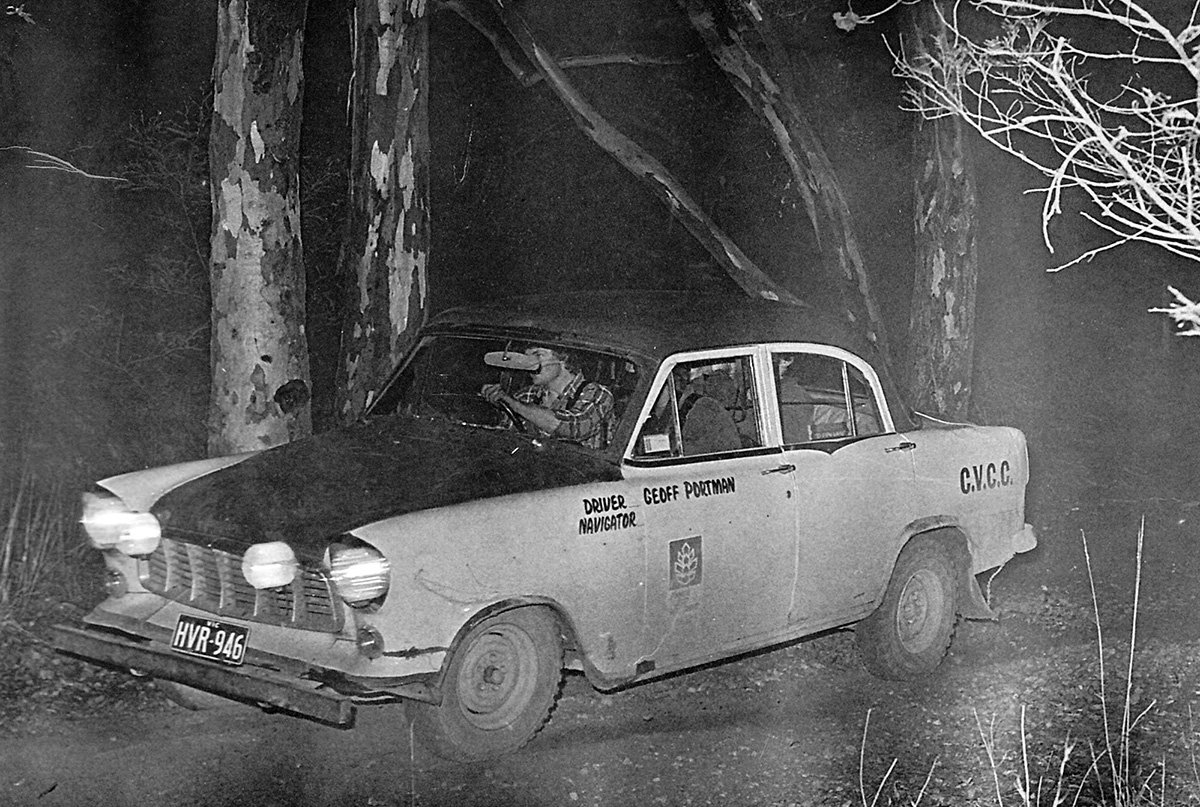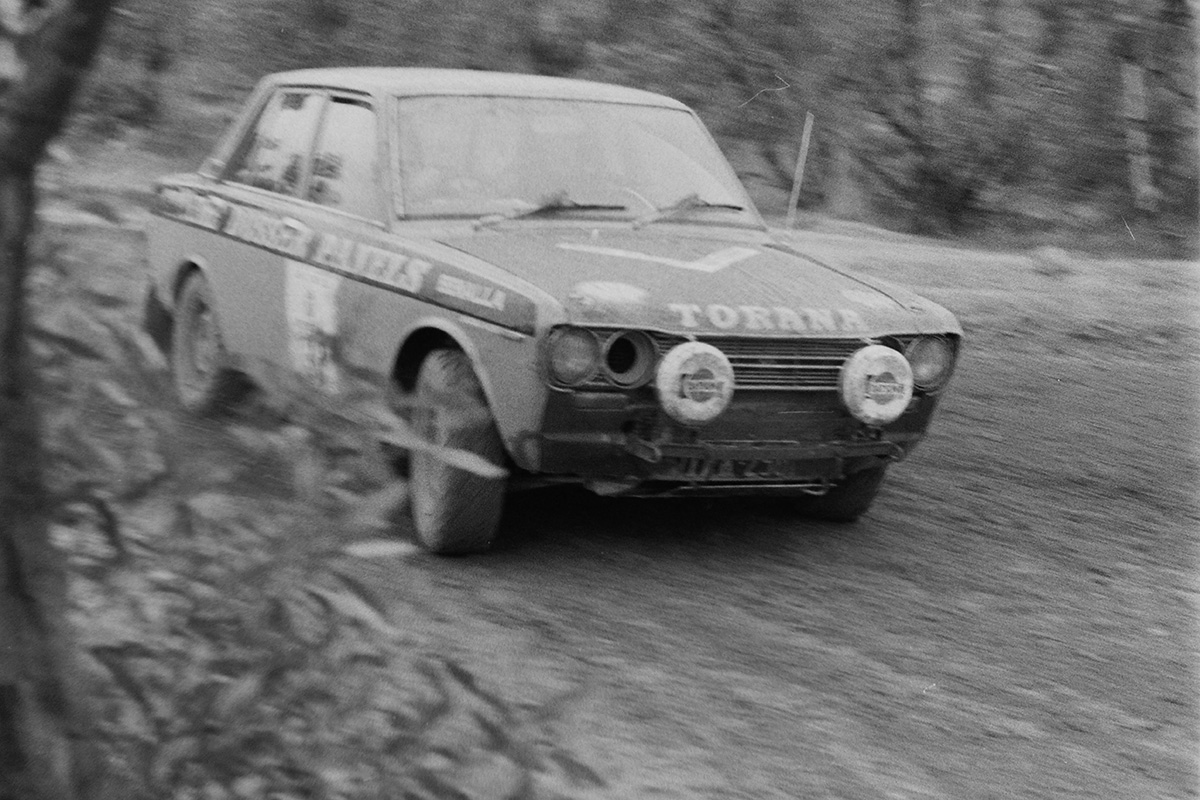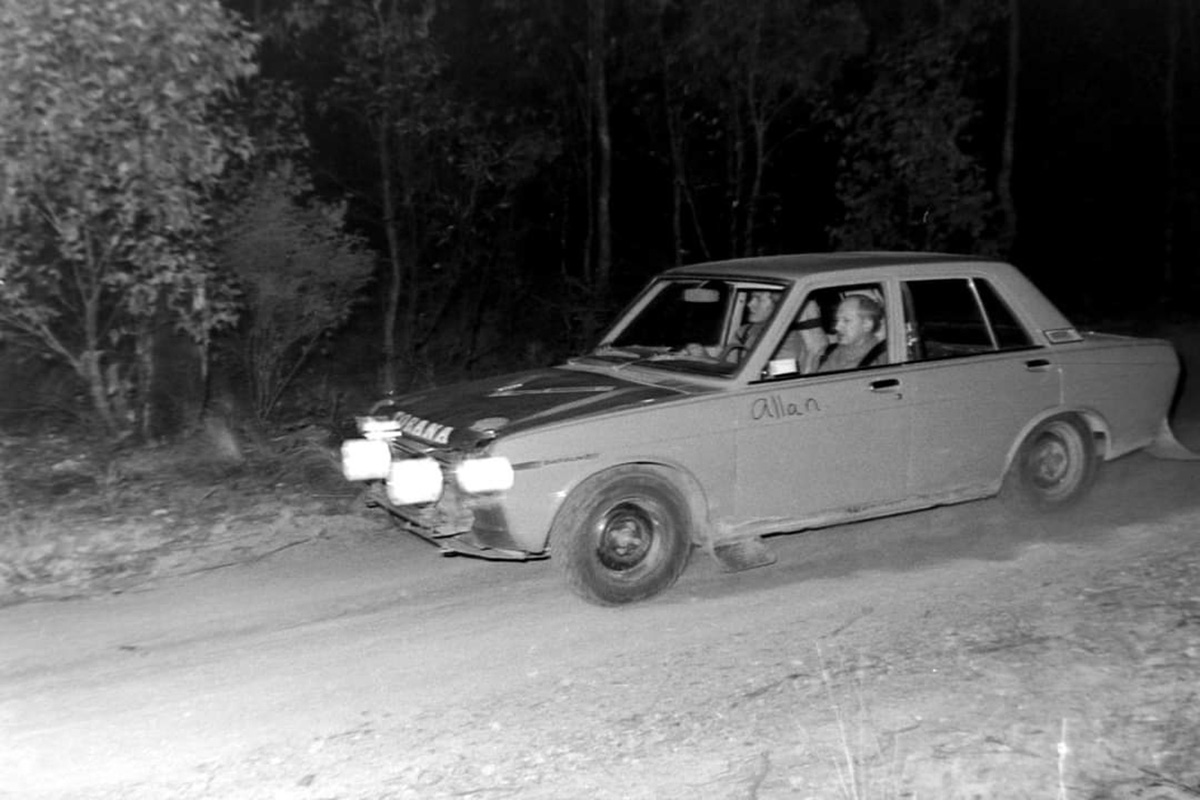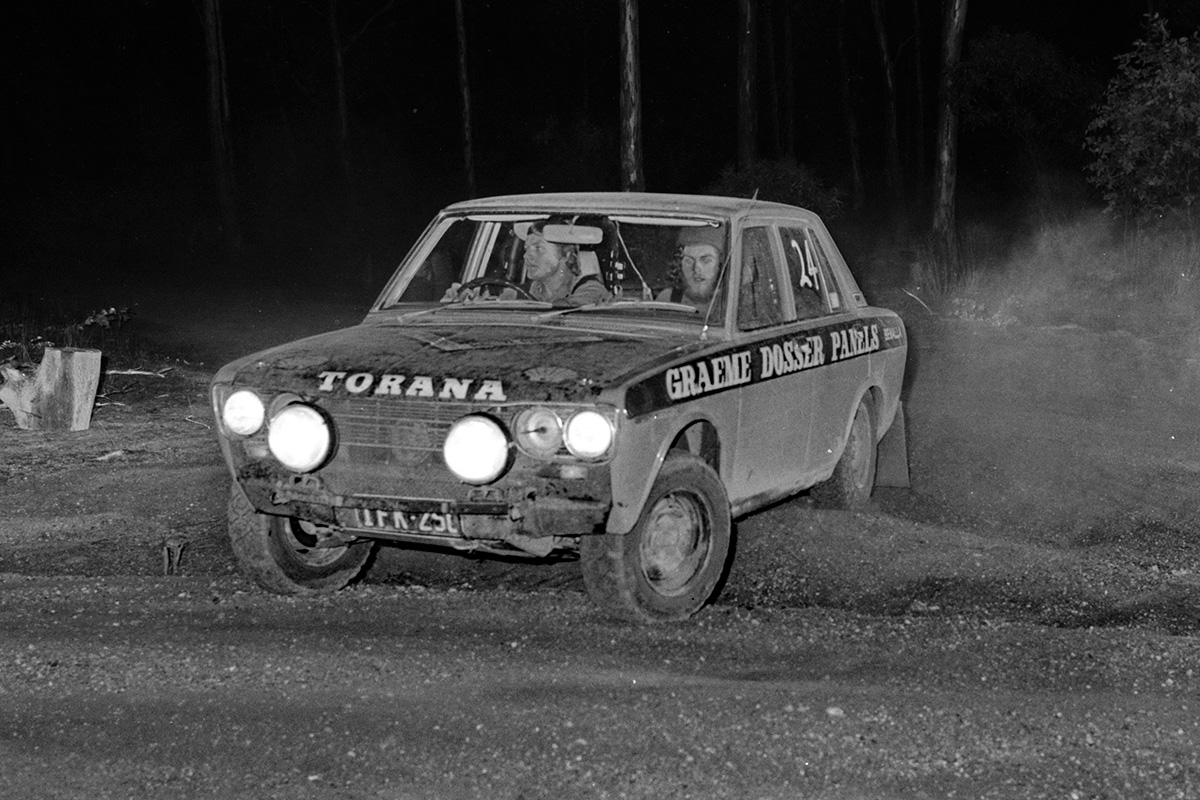There are two registration plates in Australia that evoke more emotion for rally enthusiasts than all others. One is IYK 000, a Ford Escort RS1800 that was built by Ford Motor Company competitions department in Boreham (UK) in 1977 and run in Australia by Colin Bond’s Ford Escort Rally team. It competed between October 1977 and November 1980, winning three Castrol International rallies, as well as an Australian Rally Championship (1978) in the hands of Greg Carr.
The other is IFK 250, the Victorian registration plate which was on the car that carried Geoff Portman to fame; a win in the 1978 Alpine Rally – which paved the way to a factory drive with Nissan Australia – and then to his second Australian Rally Championship in 1982.
But just another 1600? Well, for a lot of its early life, that’s just what IFK 250 was.

But before we go too far, it’s worthwhile to have a bit of background of Geoff Portman and some of the people who joined in to make this car – through its three iterations – the most famous and important Datsun 1600, certainly in Australia, if not the world.
Geoff Portman, born in 1954, was an above-average student at Eltham High School in Melborne’s North-East suburbs. The same school as Peter Brock attended, incidentally. Geoff’s family had no interest in motorsport, nor did Geoff for his first 20 years. On leaving school, he became a Forester in Victoria, having spent three years at the Victorian Forestry School in Creswick, near Ballarat. It was here that he met Ross Runnalls, a fellow Forestry student, who would become his navigator, and the two would form a lifelong friendship.
Both Geoff and Ross were in the same year at Forestry School. Ross soon became aware of Geoff’s talent behind the wheel as he chauffeured Ross through forests and shire roads in the Creswick area during Saturday night “rallies” which Ross organised for the students at the School of Forestry. Without the permission or knowledge of the schoolmasters, of course!
Ross recalls that during a drive with Geoff in his parents’ FC Holden wagon, the car just got very sideways. “Geoff just giggled, applied the correct amount of opposite lock and continued on at a fair pace. I thought this guy was actually pretty good!” Ross remembers.
Geoff soon dumped the FC and bought a 1957 FE Holden. Eventually, Ross persuaded Geoff that driving in a real rally would be a good thing. On October 19, 1974 they entered the FE in the Castlemaine-based Highlander Trial, and won it.
Geoff rapidly progressed through the ranks of Victorian and then Australian rallying to win the 1978 Alpine Rally (Colin Bond in the works Escort RS1800 was second), then the 1981 and 1982 Australian Rally Championship. He has won the Alpine Rally six times, the final occasion being in 2011 when he was 57 years old.
Portman and Runnalls
Ross Runnalls ran and won more events with Geoff Portman than anyone. Ross and Geoff’s partnership is extraordinary. Ross himself is a quiet and reserved but brilliant navigator, having partnered not only Geoff but many other drivers since 1974. He is still active in Victorian rallying.
Les Collins is best known as being the technical guru behind IFK 250. Certainly, that is true for a good part of this story. An electrical engineer by profession, Les has turned his considerable talents to developing L-series Nissan/Datsun engines further than anyone else in the world has been able to achieve. Like Ross Runnalls, he is also a quiet achiever but is immensely proud of what the Portman team were able to achieve with next to no financial resources in the late 1970s.
Another important figure in the IFK 250 story was Tom Kaitler. Tom is someone that the world needs more of. Tom and Les Collins were schoolmates at Wodonga Technical School. Tom was and still is, a rally tragic, having been, as he describes it, “hooked” since the London-Sydney Marathon in late 1968. Tom introduced Les to rallying.
A plumber by trade, Tom is one of life’s handymen who will put his mind around a task and figure it out to present a fine finished product. The more difficult the task, the better the outcome.
The final person in this rally car puzzle is Peter “Twigger” Gale. Peter is the man you want to have on your team at every step of the way. Fiercely loyal to his mates. Self-effacing. Quiet on personality. Big on actions. He possesses a never-say-die (or stop) attitude to work, especially when that work is being done for others.
We will meet each of these fine men along the way.
The birth of a legend
Let’s go back to Geoff. Having spent a year and most of his puny weekly forester’s scholarship allowance on the FE Holden, including running in the 1975 Alpine Rally, Geoff reckoned it was about time to get a newer car. A Datsun 1600 seemed like the way to go.
Through rally fraternity contacts, Geoff came across IFK 250 from Ray Gingell in Ballarat in late 1975. At the time of purchase, it was a mildly modified rally car, having been fitted with what can be loosely described as a ‘Gil Davis Club Rally Kit’.
It included a single Weber carburettor, an alloy half-cage (probably a Bond Roll Bars unit) and some uprated springs and heavy oil front struts and rear shockers (maybe S. G. Leslie units). These were pretty standard accoutrements for newbie rallyists of the era.
There was also a 4.11:1 open diff (probably from a 180B SSS) and some under-body protection. Overall nothing to write home to Mum about. It was, in fact, pretty standard. It was painted light blue.
IFK 250 set Geoff back a grand total of $2000 and was the subject of a bank loan. The strategically and financially wise Portman head figured that to be on the right side of the bank manager, he probably should start earning a wage before the car was rallied.
As well as staying friends with the bank manager, the decision not to use the 1600 in the 1975 Alpine was also due to the fact that some of the students, or as Geoff put it, ‘conscripts’ from the Victorian Forestry School, who were doubling life as Geoff and Ross’ service crew, knew little about these fan-dangled Datsun 1600s, so IFK 250 sat out the 1975 Alpine. Geoff and Ross ran the FE Holden in the Alpine that year, complete with modifications including a floor gear change and a big reverse light.
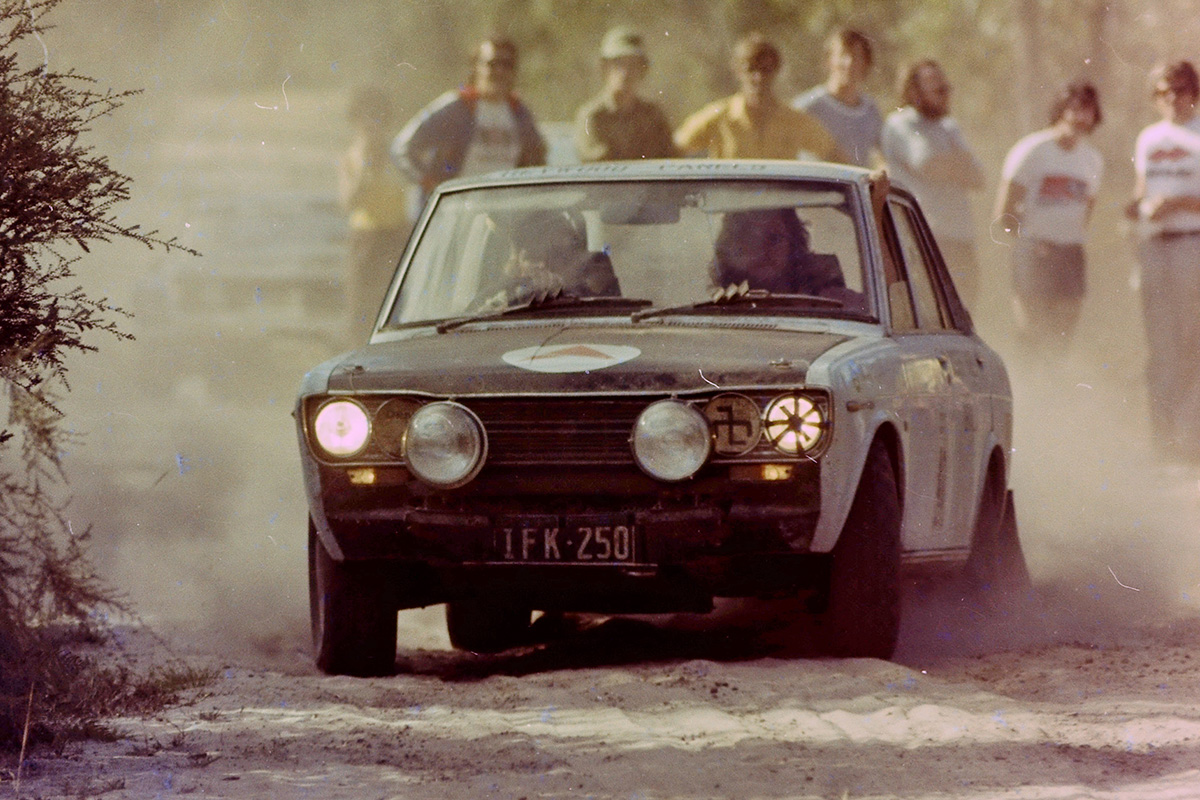
The first rally for IFK 250 in Portman’s hands was the 1976 George Derrick Memorial Trial, a two-day, part-navigational, part-route charted rally held in the forests surrounding the Western Victorian town of Hamilton. The rally was a round of the Victorian Rally Championship and the South Australian Rally Championship.
Starting at car 40, it was not long before the combination of Geoff, Ross and IFK 250 came to the notice of many onlookers and other competitors.
Geoff and Ross would finish third outright and first Grade 3 crew home. An outstandingly good result in a long, tough and dusty event, in a car which they had never before rallied. It set up a nice springboard for the future.
That was soon followed by another great result in the next Victorian Rally Championship event, this time the navigationally oriented (and tough) Brass Monkey Trial.
The Brass Monkey was an event where Ross’s mapping skills proved to be a significant contribution to the forward progress of IFK 250 and they finished fourth outright and again first Grade 3 crew.
After the Brass Monkey Trial, IFK 250 received a lick of paint around the time of the next VRC round, the Akademos Rally. The colour was best described as “baby nappy brown” and closely represented the colours of the new sponsor, Graeme Dosser Panels in Benalla. The whole crew turned out in what would now be called “corporate apparel”, but were then just called brown windcheaters, adorned with some screen printing!
This event was to be the first of many Akademos Rally hoodoos for Geoff (the rally was unusually high on his DNF rap sheet) and resulted in their very first Did Not Finish (DNF), after hitting a bank.
Not to be deterred, next up was the navigationally (very) difficult Experts Trial – the following VRC round – which included 100km of daylight route charted stages around the Puckapunyal Army Range.
Again, an excellent result with a fourth outright and yet another first Grade 3.
A not-so-happy result was in the 1976 Hunter Safari when a lower control arm broke while the pair were leading. Another DNF.
It was a lousy alternator lead that played havoc with the car during the following event, the North Eastern Rally – which was a round of the 1976 Australian Rally Championship. Hopes were high for a good result as it was being run around the forests of Beechworth. Geoff was stationed in Stanley at the time and he knew the roads like the proverbial back of his hand.
The crew would come home in seventh outright and still first Grade 3.
Geoff and Ross and their partnership with IFK 250 was getting better all the time …
A standout performance of that event was Geoff setting the fastest time (in an ARC field, remember!) on the ‘Champagne Section’ – the longest and roughest competitive stage of the rally, which just happened to be run in the pine plantations surrounding the tiny township of Stanley. Ross had a chuckle about that one: “They handed the champers to Greg Carr because we were so far back, no one noticed our time!”
He continued: “Given that Geoff was more familiar with the roads than I was, it was quite a ride in what was then a very basic Datsun 1600 rally car.”
The following event was the Melbourne University Car Club’s Winter Trial in July and was the only event IFK 250 did that year without Ross Runnalls in the left-hand seat. The replacement navigator on this occasion was Allan Portman – Geoff’s Dad! They finished in equal second place. Ironically, Ross, who was navigating for Hadyn West, was also equal second.
The Victorian Rally Championship continued with the Eclipse Motors Rally around Scarsdale near Ballarat and Creswick. This resulted in a busted rear trailing arm – a bit of a disease with 1600s – and another DNF.
But then tragedy struck. On the way home from the Eclipse Rally, IFK 250 was involved in a rollover entering the town of Tarrawingee, only a scant few kilometres from Geoff’s digs (at the time that was near Beechworth).
A friend, “one of the Creswick recruits” as Geoff fondly referred to his anonymous crew member, was driving while an exhausted Geoff slept in the passenger seat. The car was pretty badly banged up.
A replacement shell was soon procured. This time its colour was light green. It was the end of the first iteration of IFK 250. The registration plate, however, was kept on the new shell.
Once the engine and running gear was firmly ensconced in the new shell, other necessary parts were transferred across, like roll cages and navigational gear. The next event on the schedule was the Holden Dealers International, an all-daylight Special Stage Rally around the plantations near Traralgon in Gippsland.
After the rollover, the nice brown colour scheme was ditched in favour of the new (light green) replacement body.
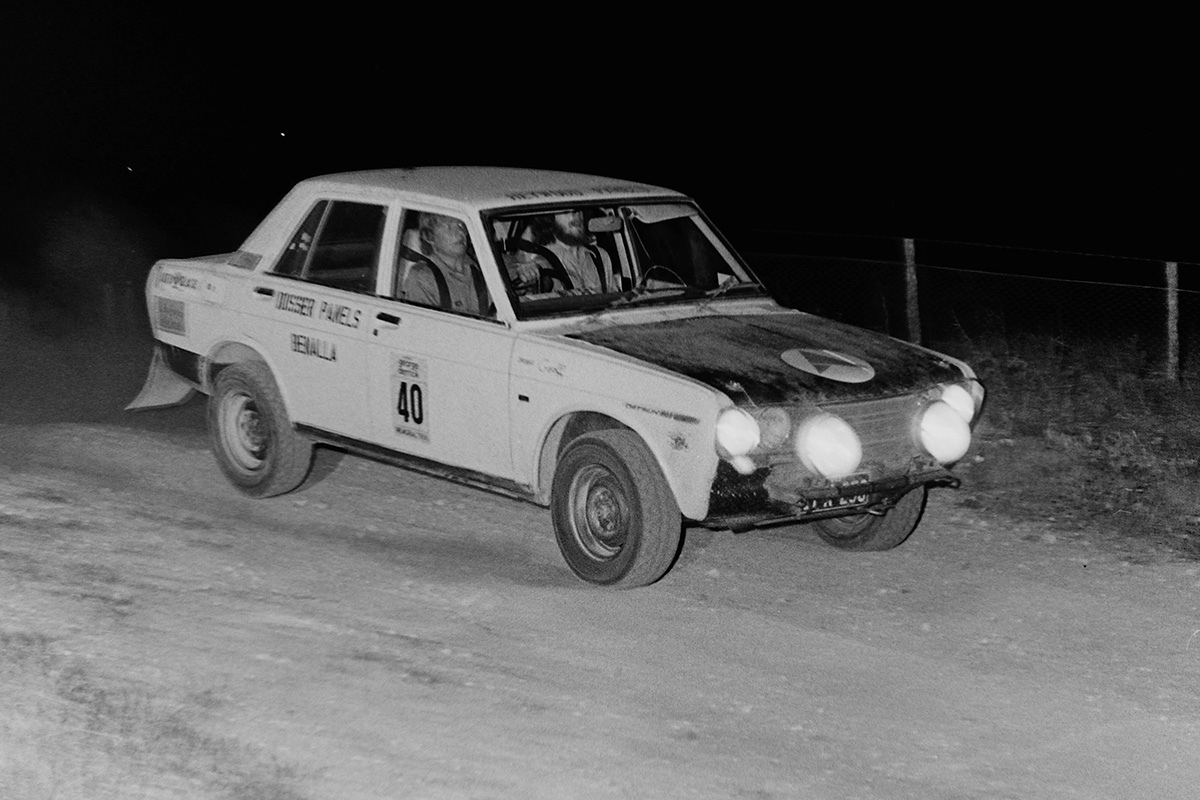
Preparation time was tight and after all, a few licks of paint and a bit of panel damage would not have a detrimental effect on the car’s performance, would it? As a result, some pretty rough panel beating and multi-coloured panels were an unintentional ‘feature’ of the car.
Not surprisingly, the car was knocked back by the scrutineers and the boys did not even get to start.
However “hip” such a colour scheme may be in 2024, it was a distinctly bad taste for 1976, especially for the Holden Dealers International organisers who really wanted all the field to be as sparkling and pristine as possible, in keeping with the desired status of the event. The easy way out for the organisers was to reject the car at scrutiny, so they did.
Prior to the next event, body repairs and repainting were completed to a far more appropriate and professional standard!
Three more rallies were on the agenda for 1976; the Alpine Rally, in which the car was in a splendid fourth outright position when the alternator failed and resulted in a DNF; a very wet CCRMIT Presidents Rally around Powelltown, which netted a fine third place; and the Mobil Kippax Rally held in Canberra – no doubt for a bit of practice for the forthcoming Castrol International Rally the following year.
The result of this foray into the ACT Forests is not proven through official documentation, but thanks to Ross Runnalls’ competition history notes, it’s probably safe to say they started in ninth position and a bent strut caused some havoc, putting a stop to their rally, and a DNF resulted.
After a summer of rebuilding, regenerating and reorganising finances and the like – the first of what would be many similar annual occurrences for Geoff, usually achieved through additional summer work with the Forests Commission of Victoria – the 1977 rally season was to be a busy one for Geoff and Ross.
Photos in this feature have been contributed by: Bruce Keys, Dallas Dogger, John Lemm, Ken Cusack, David Balfour, Ray Berghouse/Chevron Publishing, Peter Whitten, Ian Long, Tom Kaitler, B Team Rally Media.

